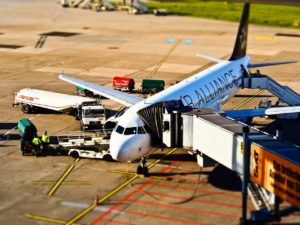America’s airports are abuzz as big changes take place. Upgrades, expansions, diverse transportation options, and all kinds of new amenity projects are either underway or being prepared for launch. Planning is rampant as air travel is modernized, made safer and more convenient. However, the current activity and the projects underway at airports today will likely pale in comparison to what will soon be the norm.
Airport modernization is necessary for many reasons – excessive growth in the number of passengers, global competition, aging facilities, and an increased focus on safety.
The Transportation Security Administration (TSA) has added new regulations for airports. The threat of cyberbreaches escalates as technology networks age and cyberattack agents become more sophisticated. Because of that, technology enhancement projects are very common at airports. The TSA has also incentivized airlines to harden the resilience of digital networks. Now, networks are being segmented to ensure that the systems are not all impacted if any one of them is compromised. Continual detection monitoring is also required along with daily testing of all network security protections.
Along with air safety, there is currently a great emphasis on passenger convenience. Most passengers rely heavily on connected and digitized networks that provide information and facilitate transitions. They are all vulnerable to cyber threats and just last year, pro-Russian hackers disrupted airline websites in Atlanta, Chicago, New York, and Los Angeles. No flights were impacted, and no data was lost but the incident was frightening, and disruptive. To support new required technology implementations, more than $2 billion in federal funding has already been allocated. The funding is available for projects that include network security, artificial intelligence (AI), 5g, biometrics, digital identity, robotics, and internet of things (IoT) sensors.

A $34 million airport project at the Baltimore/Washington International Airport may be ready for contracting opportunities in 2024. The launch date will depend on progress made by the design team this year. The project’s objective will be to expand and significantly enhance the baggage handling system at the airport. Oversight will be directed by the Maryland Aviation Administration.
A $40 million project to construct a pedestrian bridge at the Ronald Reagan National Airport is currently on hold until an environmental review is completed. The new bridge will connect the airport to Crystal City, a neighborhood in Arlington County. Once completed, the new bridge will allow for more diverse transit options that connect to the airport.
Phase #1 of a large airport initiative that carries a price tag of $1.6 billion is scheduled to launch in late 2024 at the Dallas-Fort Worth International Airport in Texas. The effort will include construction of a new terminal,15 new gates, and state-of-the-art facilities and amenities. A modernized baggage-handling system will be installed, leading edge technology will be deployed, and the expansion will be structured to accommodate the 100 million travelers that are expected to frequent the airport annually within the next 6 to 7 years. The airport’s current customer count is about 78 million passengers a year.
Also, in Texas, the Austin-Bergstrom International Airport has announced an airport optimization and expansion plan that could eventually cost even more – potentially up to $6 billion. However, while the massive initiative is yet to be finalized, a $165 million plan that includes a West End expansion of the existing Barbara Jordan Terminal is scheduled to launch soon.
A $650 million project at the Raleigh-Durham Airport in North Carolina will be designed to meet current growth in passenger volume. The plan includes roadway work between terminals to allow for construction of a new car rental facility. It also includes expanding the airport’s Terminal #2 and modifying the landscape surrounding the Federal Inspections and Custom Border Patrol areas.
In Pennsylvania, a $12 million project is planned for the Wilkes-Barre/Scranton International Airport. Not only will the project expand and redesign the terminal space, other components will provide more efficient traffic lanes for arriving and exiting passengers, a new family waiting area, a business center, and an expedited passenger security check in system. The project is scheduled for a 2024 launch.
Two taxiways will be extended at the Los Angeles International Airport in early 2025. The project , which is expected to take three years for completion, carries a projected cost of somewhere between $150 million and $200 million. The project sponsor, Los Angeles World Airports, will also launch a smaller project ($15 – $25 million) for reconstruction work at the Van Nuys Airport in 2024.
A new air control tower will be constructed at the Deluth Airport in Minnesota to replace an existing 70 year old tower. Once a final decision has been made about exactly where the new tower will be located, redevelopment of the adjacent property will begin. Site selection and final planning work will be completed in 2024.
Air travel will continue to increase and the aviation sector in America will undergo massive changes into the next decade. Electric planes that reduce noise and air pollution are being designed. New filtration systems that enhance air safety for passengers are being installed, and competitive pressure is forcing the prioritization of passenger comfort. Private sector companies will find an abundance of opportunities and diverse ways to collaborate with airline officials to help ensure that America’s airports remain competitive worldwide.






